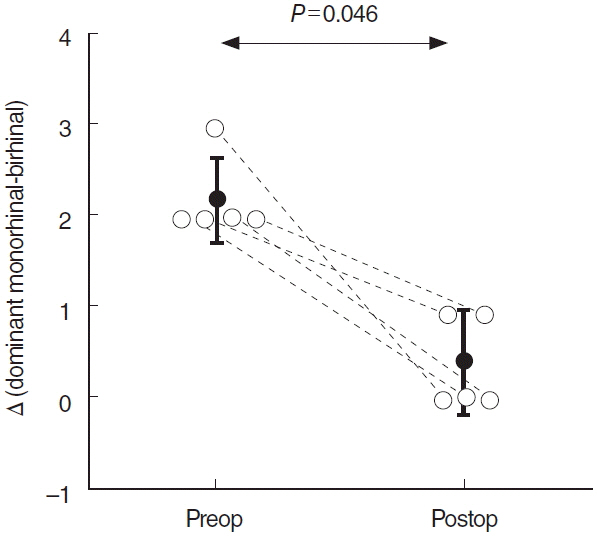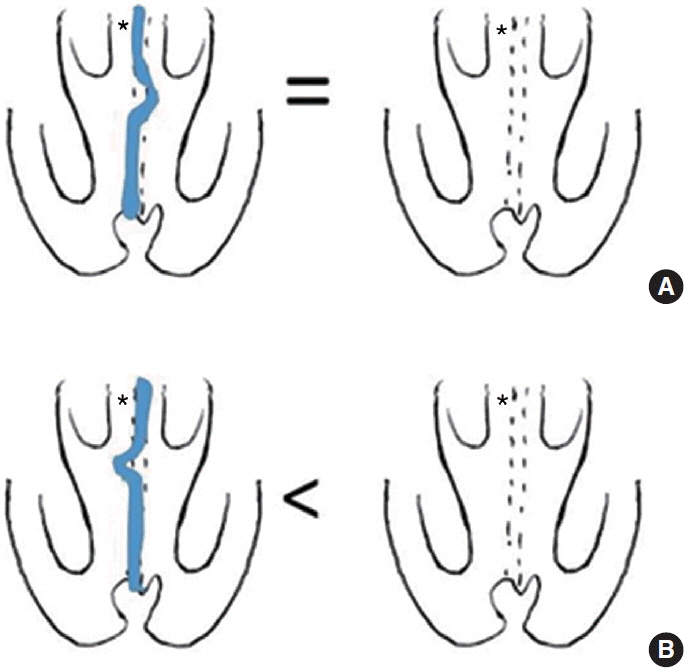Clin Exp Otorhinolaryngol.
2016 Mar;9(1):39-43. 10.21053/ceo.2016.9.1.39.
Clinical Implications of Septal Deviation in Lateralized Olfaction
- Affiliations
-
- 1Department of Otorhinolaryngology-Head and Neck Surgery, Seoul Metropolitan Government-Seoul National University Boramae Medical Center, Seoul National University College of Medicine, Seoul, Korea. kicubi@daum.net
- KMID: 2166284
- DOI: http://doi.org/10.21053/ceo.2016.9.1.39
Abstract
OBJECTIVES
Results of butanol threshold tests (BTTs) have shown that birhinal olfaction tends to converge toward monorhinal olfaction of the dominant nostril. However, birhinal olfaction may also be worse than dominant-side monorhinal olfaction. The goal of our study was to investigate the effect of deviated nasal septum on birhinal olfaction in patients with lateralized olfaction and to examine the effect of septoplasty in these patients.
METHODS
A retrospective study with planned data collection was conducted in 518 patients who underwent BTTs. Lateralized olfaction was defined as monorhinal BTT scores that differed by >2 between sides. Underestimated birhinal olfaction was defined as a birhinal BTT score >2 lower than the dominant nostril monorhinal BTT score. Patients with lateralized olfaction were divided into 2 groups: group 1, underestimated birhinal olfaction; and group 2, without underestimated birhinal olfaction.
RESULTS
Among 518 patients, 112 with lateralized olfaction were enrolled in this study. Group 1 included 23 patients (20.5%) and group 2 included 89 patients (79.5%). The severity of septal deviation (ratio of the distance of narrower side to wider side) did not differ between the 2 groups. Septal deviation to the dominant nostril was more common in group 1 than group 2 (73.9% vs. 37.6%; P=0.002). Five patients with septal deviation to the dominant nostril with underestimated birhinal olfaction underwent septoplasty. Improved lateralized olfaction occurred in all 5 patients postoperatively (P=0.041).
CONCLUSION
Septal deviation of the dominant nostril in patients with lateralized olfaction is associated with underestimated birhinal olfaction. Septoplasty may improve olfaction by increasing airflow in the dominant olfactory side.
Keyword
Figure
Reference
-
1. Good KP, Martzke JS, Daoud MA, Kopala LC. Unirhinal norms for the University of Pennsylvania Smell Identification Test. Clin Neuropsychol. 2003; May. 17(2):226–34.
Article2. Mohr C, Rohrenbach CM, Laska M, Brugger P. Unilateral olfactory perception and magical ideation. Schizophr Res. 2001; Mar. 47(2-3):255–64.
Article3. Zucco G, Zeni MT, Perrone A, Piccolo I. Olfactory sensitivity in early-stage Parkinson patients affected by more marked unilateral disorder. Percept Mot Skills. 2001; Jun. 92(3 Pt 1):894–8.
Article4. Brand G, Millot JL, Biju C. Comparison between monorhinal and birhinal olfactory stimulations in bilateral electrodermal recordings. C R Acad Sci III. 2000; Nov. 323(11):959–65.
Article5. Gudziol V, Hummel C, Negoias S, Ishimaru T, Hummel T. Lateralized differences in olfactory function. Laryngoscope. 2007; May. 117(5):808–11.
Article6. Klimek L, Hummel T, Moll B, Kobal G, Mann WJ. Lateralized and bilateral olfactory function in patients with chronic sinusitis compared with healthy control subjects. Laryngoscope. 1998; Jan. 108(1 Pt 1):111–4.
Article7. Frasnelli J, Livermore A, Soiffer A, Hummel T. Comparison of lateralized and binasal olfactory thresholds. Rhinology. 2002; Sep. 40(3):129–34.8. Gordon AS, McCaffrey TV, Kern EB, Pallanch JF. Rhinomanometry for preoperative and postoperative assessment of nasal obstruction. Otolaryngol Head Neck Surg. 1989; Jul. 101(1):20–6.
Article9. Mlynski G. Surgery of the nasal septum. Facial Plast Surg. 2006; Nov. 22(4):223–9.
Article10. Kamani T, Yilmaz T, Surucu S, Turan E, Brent KA. Scanning electron microscopy of ciliae and saccharine test for ciliary function in septal deviations. Laryngoscope. 2006; Apr. 116(4):586–90.
Article11. Altundag A, Salihoglu M, Tekeli H, Saglam M, Cayonu M, Hummel T. Lateralized differences in olfactory function and olfactory bulb volume relate to nasal septum deviation. J Craniofac Surg. 2014; Mar. 25(2):359–62.
Article12. Damm M, Vent J, Schmidt M, Theissen P, Eckel HE, Lötsch J, et al. Intranasal volume and olfactory function. Chem Senses. 2002; Nov. 27(9):831–9.
Article13. Kimmelman CP. The risk to olfaction from nasal surgery. Laryngoscope. 1994; Aug. 104(8 Pt 1):981–8.
Article14. Pfaar O, Huttenbrink KB, Hummel T. Assessment of olfactory function after septoplasty: a longitudinal study. Rhinology. 2004; Dec. 42(4):195–9.15. Leopold DA, Hummel T, Schwob JE, Hong SC, Knecht M, Kobal G. Anterior distribution of human olfactory epithelium. Laryngoscope. 2000; Mar. 110(3 Pt 1):417–21.
Article16. Zhao K, Scherer PW, Hajiloo SA, Dalton P. Effect of anatomy on human nasal air flow and odorant transport patterns: implications for olfaction. Chem Senses. 2004; Jun. 29(5):365–79.
Article17. Jun BC, Song SW, Kim BG, Kim BY, Seo JH, Kang JM, et al. A comparative analysis of intranasal volume and olfactory function using a three-dimensional reconstruction of paranasal sinus computed tomography, with a focus on the airway around the turbinates. Eur Arch Otorhinolaryngol. 2010; Sep. 267(9):1389–95.
Article18. Hytönen ML, Lilja M, Makitie AA, Sintonen H, Roine RP. Does septoplasty enhance the quality of life in patients? Eur Arch Otorhinolaryngol. 2012; Dec. 269(12):2497–503.
Article19. Perry BF, Kountakis SE. Subjective improvement of olfactory function after endoscopic sinus surgery for chronic rhinosinusitis. Am J Otolaryngol. 2003; Nov-Dec. 24(6):366–9.
Article20. Gudziol V, Lotsch J, Hahner A, Zahnert T, Hummel T. Clinical significance of results from olfactory testing. Laryngoscope. 2006; Oct. 116(10):1858–63.
Article21. Doty RL. Office procedures for quantitative assessment of olfactory function. Am J Rhinol. 2007; Jul-Aug. 21(4):460–73.
Article
- Full Text Links
- Actions
-
Cited
- CITED
-
- Close
- Share
- Similar articles
-
- Correction of Caudal Septal Deviation: Septal Batten Graft with a Bioabsorbable Plate
- The Effect of Nasal Septal Deviation and Septoplasty on Dacryocystorhinostomy Progression
- Structural Changes of Inferior Turbinate in Patients with Septal Deviation: Surgical Implication
- Using nasal septal cartilage-bone complex for anterior septal reconstruction in Asians
- Histologic difference of the nasal mucosa of both nasal cavities in patients with nasal septal deviation





